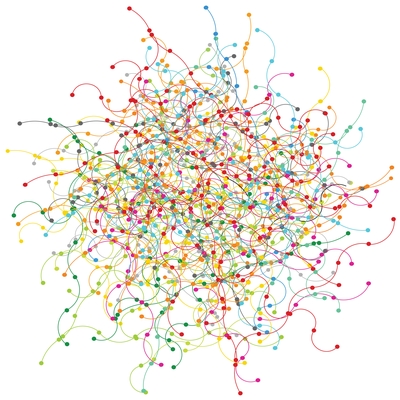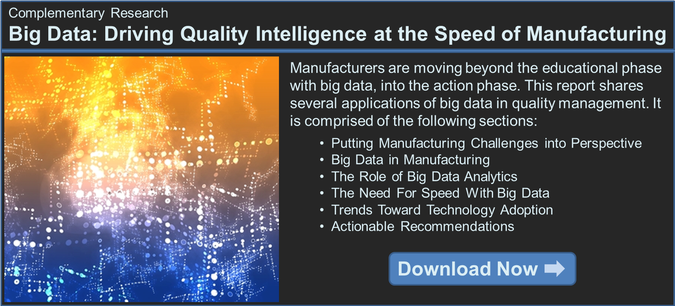 The topic of “The Power of Connection” has been all over the news, dealing with social networking and our personal lives. Metcalfe’s Law was one of the first attempts to illustrate the value of connection and in manufacturing it is proving to be a powerful indicator of business success.
The topic of “The Power of Connection” has been all over the news, dealing with social networking and our personal lives. Metcalfe’s Law was one of the first attempts to illustrate the value of connection and in manufacturing it is proving to be a powerful indicator of business success.
The more connectivity that exists, the better a business can run. Whether it is ensuring product quality, operating efficiency or sustainability, the more devices connected, the more information you have. And the more powerful the tools you have to use that information, the more value that can be returned to a business' stakeholders.
This has to be balanced against the reality of diminishing returns. The incremental usefulness of additional information very quickly diminishes after a certain point. You need sufficient information to make a decision, but after some point additional information serves only to validate the decision, which may reduce risk but does not change the decision itself. So to determine the value of additional information you also need to know the cost of obtaining that information.
Internet of Things (IoT) technology and the tools available for consuming and contexualizing small and Big Data sets today are changing the game for both the cost of connections and their utility. In this post, we'll inspect this idea more in depth.
The IoT Drastically Lowers the Incremental Cost of Information
The idea that having more than one measurement about the state of a manufacturing process allows for better control is not new. Good process control design would dictate that you might look at temperature and pressure or pressure and flow, or even all three to regulate a particular process. In the past, where sensors were expensive and each had to be hardwired back to a control system, often at a cost matching the sensors themselves, the number of process measurements was driven by using as few as possible to obtain satisfactory control--typically at a 3 sigma level.
Digital sensors and wireless networking on the plant floor, introduced a decade ago, started to radically change the equation. Digitization drastically reduced the cost of sensors, with many sensed parameters being available in a single package. Digital networking was the first step in reducing connection costs with far more information capable of being sent on a single pair than the 4-20ma analog standard allowed. Finally wireless further lowered costs with there no longer being the need to run miles of copper throughout a facility.
Now, the IoT will further reduce the incremental costs. In the past there were competing wireless protocols that resulted in islands of information that required bridging to bring the information together. The IoT will greatly improve the situation although there will still be issues. Things like time synchronization, units of measure, and even the accuracy and precision of the information will remain challenges that even the IoT has yet to address.
Even so, as with most technologies that have moved into the industrial space from the consumer sector, the costs will drop to the point that sheer redundancy of information will help mitigate some of the uncertainties introduced by the factors just cited. Twenty-five years ago there was the belief in automation that a deterministic token-based network was required to pass control information reliably. It took less than ten years for the common Ethernet-based probabilistic networking that prevails today, and through evolution driving speeds ever higher that determinism became a non-issue.
The IoT and Big Data – Not the Same Thing but Intrinsically Linked
One of the challenges when talking about the IoT is how different people define the IoT and the same holds true of Big Data. Since the IoT includes consumer-centric devices, as well as commercial and industrial elements, much of the data available throughout the IoT will seem to have minimal value on the plant floor but that may not be the case. We’ll explore that in a second.
Big Data also suffers from the same lack of precision as the IoT. Different organizations have different data processing capabilities so what may be Big Data to one may not be a data processing challenge using traditional tools to another organization. There is also the problem of both the integrity of the data as well as the relationship of the data. As my colleague Mike Roberts pointed out in his recent blog post, an analysis of solar activity in 1929 closely followed the New York and London stock indices implying either sunlight drove stock prices or stock prices drove the amount of sunlight that fell on the earth. This turned out to only be relevant in a very short timespan.
The challenge then will be to take all of the data that will be accessible from the IoT and use Big Data analytics to derive MEANINGFUL information from the tsunami of data.
The Key to Driving the Power of Connection is Blue Ocean Thinking
In their book “Blue Ocean Strategy,” W. Chan Kim and Renee Mauborgne put forth the argument that companies best succeed not by making small incremental gains but by creating “blue oceans” of uncontested opportunities. The key is value innovation--the simultaneous pursuit of low cost and unique differentiation. While the book is about creating whole new business models such as the way Cirque du Soleil did when it created a circus with only one “ring” and no animals, the principals from the book can also be applied within an existing enterprise to create whole new business opportunities.
One such shift, that has been mentioned several times in various LNS Research posts, is the idea of selling a service instead of a product. Examples typically revolve around an OEM delivering the output of the device it sells instead of the device itself. An example is a jet engine manufacturer selling pound-hours of thrust instead of the engine itself. The engine manufacturer measures the output of the engine and bills the airline for the use and wear-and-tear on the engine instead of selling them an engine and spares up front. The engine OEM also provides all the service and spares as part of this service. As we noted in past posts, the key to doing this profitably is having enough information so you can deliver the capacity reliably and at a price point which you can be profitable.
A variation on using the improved information that can be obtained via the IoT that has also been previously discussed is the idea of an OEM taking data from all of its products as used in the field and aggregating and using this richer set of data to provide insight to the end-user on how to better maintain and operate its equipment than it might be able to ascertain itself with the limited data few pieces of equipment might provide.
As promised above, here are some “blue ocean” ideas that might leverage the consumer side of the IoT in the industrial workplace:
- Using the biometric data that devices like hydration sensors, heart rate monitors, and other sensors to gauge employee health and performance while on the job
- Using features of wearable devices and personal communication devices to track and locate employees for safety and security reasons
- Biometric scanning like fingerprint recognition to validate identity and appropriateness of people performing certain tasks
These are but a few ideas. As the IoT and the information it makes available starts to proliferate through industry, the “Power of Connection” will really start to emerge.
